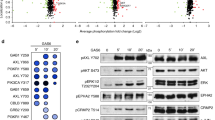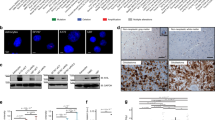Abstract
Focal adhesion kinase (FAK) signaling may be mediated through the modulation of Ras activity. We have shown previously that grade III malignant astrocytoma biopsy samples exhibit elevated levels of FAK, and that overexpression of FAK in U-251MG malignant astrocytoma cells promotes the phosphorylation of Shc, a potential upstream mediator of Ras activity. Here, we report that overexpression of FAK promotes Ras activity in U-251MG malignant astrocytoma cells cultured in aggregate suspension or as monolayers adherent to vitronectin. The overexpression of FAK also promoted the association of FAK with p120RasGAP, which is a negative regulator of Ras activity, in the U-251MG cells cultured in aggregate suspension, with this association being abrogated upon plating of the cells onto vitronectin. An association of FAK with p120RasGAP also was observed in malignant astrocytoma biopsy samples, but not in normal brain samples. As overexpression of FAK in U-251MG cells in aggregate suspension culture reduced the amount of p120RasGAP complexed with active Ras, we hypothesize that the association of FAK with p120 RasGAP may facilitate Ras activity. The overexpression of a mutated FAK in which the Y397 had been mutated to F did not result in the formation of the FAK/p120RasGAP complex and did not promote Ras activity, indicating that the Y397 residue of FAK plays a role in the formation of this complex and in the activation of Ras. Moreover, the overexpression of mutated FAK (397F) was found to inhibit anchorage-independent growth. These data provide the basis for a previously undescribed mechanism in which the elevated expression of FAK can promote Ras activity through its competitive recruitment of p120RasGAP, thereby diminishing the association of p120RasGAP with active Ras.
This is a preview of subscription content, access via your institution
Access options
Subscribe to this journal
Receive 50 print issues and online access
$259.00 per year
only $5.18 per issue
Buy this article
- Purchase on Springer Link
- Instant access to full article PDF
Prices may be subject to local taxes which are calculated during checkout






Similar content being viewed by others
References
Bar-Sagi D and Hall A . (2000). Cell, 103, 227–238.
Brott BK, Decker S, Shafer J, Gibbs JB and Jove R . (1991). Proc. Natl. Acad. Sci. USA, 88, 755–759.
Cacalano NA, Sanden D and Johnston JA . (2001). Nat. Cell Biol., 3, 460–465.
Calalb MD, Polte TR and Hanks SK . (1995). Mol. Cell. Biol., 15, 954–963.
Clark GJ, Westwick JK and Der CJ . (1997). J. Biol. Chem., 272, 1677–1681.
Crews CM and Erikson RL . (1993). Cell, 74, 215–217.
Ding H, Roncari L, Shannon P, Wu X, Lau N, Karaskova J, Gutmann DH, Squire JA, Nagy A and Guha A . (2001). Cancer Res., 61, 3826–3836.
Ellis C, Moran M, McCormick F and Pawson T . (1990). Nature, 343, 377–381.
Guha A . (1998). Can. J. Neurol. Sci., 25, 267–281.
Guha A, Feldkamp MM, Lau N, Boss G and Pawson A . (1997). Oncogene, 15, 2755–2765.
Hecker TP, Grammer JR, Gillespie GY, Stewart J and Gladson CL . (2002). Cancer Res., 62, 2699–2707.
Kashige N, Carpino N and Kobayashi R . (2000). Proc. Natl. Acad. Sci. USA, 97, 2093–2098.
Kiyokawa E, Mochizuki N, Kurata T and Matsuda M . (1997). Crit. Rev. Oncog., 8, 329–342.
Kleihues P, Burger PC and Scheithauer BW . (1993). Brain Pathol., 3, 255–268.
Kornberg LJ . (1998). Head Neck, 20, 745–752.
Lieubeau-Teillet R, Rak J, Jothy S, Iliopoulos O, Kaelin W and Kerbel RS . (1995). Cancer Res., 58, 4957–4962.
Luzi L, Confalonieri S, Di Fiore PP and Pelicci PG . (2000). Curr. Opin. Genet. Dev., 10, 668–674.
Marshall MS, Hill WS, Assunta SN, Vogel US, Schaber MD, Scolnick EM, Dixon RAF, Sigal IS and Gibbs JB . (1989). EMBO J., 8, 1105–1110.
Mohan PM, Chintala SK, Mohanam S, Gladson CL, Kim ES, Gokaslan ZL, Lakka SS, Roth JA, Fang B, Sawaya R, Kyritsis AP and Rao JS . (1999). Cancer Res., 59, 3369–3373.
Parsons JT, Martin KH, Slack JK, Taylor JM and Weed SA . (2000). Oncogene, 19, 5606–5613.
Polte TR and Hanks SK . (1997). J. Biol. Chem., 272, 5501–5509.
Renshaw MW, Price LS and Schwartz MA . (1999). J. Cell Biol., 147, 611–618.
Roy S, Ruest PJ and Hanks SK . (2002). J. Cell. Biochem., 84, 377–388.
Schaller MD, Hildebrand JD, Shannon JD, Fox JX, Vines RR and Parsons JT . (1994). Mol. Cell. Biol., 14, 1680–1688.
Schlaepfer DD, Hanks SK, Hunter T and van der Geer P . (1994). Nature, 372, 786–791.
Schlaepfer DD, Jones JK and Hunter T . (1998). Mol. Cell. Biol., 18, 2571–2585.
Serpente N, Birling M-C and Price J . (1996). Mol. Cell. Neurosci., 7, 391–403.
Sieg DJ, Hauck CR and Schlaepfer DD . (1999). J. Cell Sci., 112, 2677–2691.
Slack JK, Adams RB, Rovin JD, Bissonette EA, Stocker CE and Parsons JT . (2001). Oncogene, 20, 1152–1163.
Tocque B, Delumeau I, Parker F, Maurier F, Multon MC and Schweighoffer F . (1997). Cell Signal., 9, 153–158.
Trahey M and McCormick F . (1987). Science, 238, 542–545.
Wang D, Grammer JR, Cobbs CS, Stewart JE, Liu Z, Rhoden R, Hecker TP, Ding Q and Gladson CL . (2000). J. Cell Sci., 113, 4221–4230.
White MA, Nicolette C, Minden A, Polverini A, Aelst LV, Karin M and Wigler MH . (1995). Cell, 80, 533–541.
Xing Z, Chen HC, Nowlen JK, Taylor SJ, Shalloway D and Guan J-L . (1994). Mol. Cell. Biol., 5, 413–421.
Acknowledgements
This work was supported by Grants #CA59958 and CA97110 from the National Institutes of Health-National Cancer Institute to CLG, #GM49882 from the National Institutes of Health-Institute of General Medical Sciences to SKH, and a National Brain Tumor Foundation grant to QD.
Author information
Authors and Affiliations
Corresponding author
Rights and permissions
About this article
Cite this article
Hecker, T., Ding, Q., Rege, T. et al. Overexpression of FAK promotes Ras activity through the formation of a FAK/p120RasGAP complex in malignant astrocytoma cells. Oncogene 23, 3962–3971 (2004). https://doi.org/10.1038/sj.onc.1207541
Received:
Revised:
Accepted:
Published:
Issue Date:
DOI: https://doi.org/10.1038/sj.onc.1207541
Keywords
This article is cited by
-
Increasing cancer permeability by photodynamic priming: from microenvironment to mechanotransduction signaling
Cancer and Metastasis Reviews (2022)
-
Suppression of TGF-β1 signaling by Matrigel via FAK signaling in cultured human trabecular meshwork cells
Scientific Reports (2021)
-
Focal Adhesion Kinase Regulates Hepatic Stellate Cell Activation and Liver Fibrosis
Scientific Reports (2017)
-
Focal adhesion kinase-promoted tumor glucose metabolism is associated with a shift of mitochondrial respiration to glycolysis
Oncogene (2016)
-
Focal Adhesion Kinase Regulates Fibroblast Migration via Integrin beta-1 and Plays a Central Role in Fibrosis
Scientific Reports (2016)



